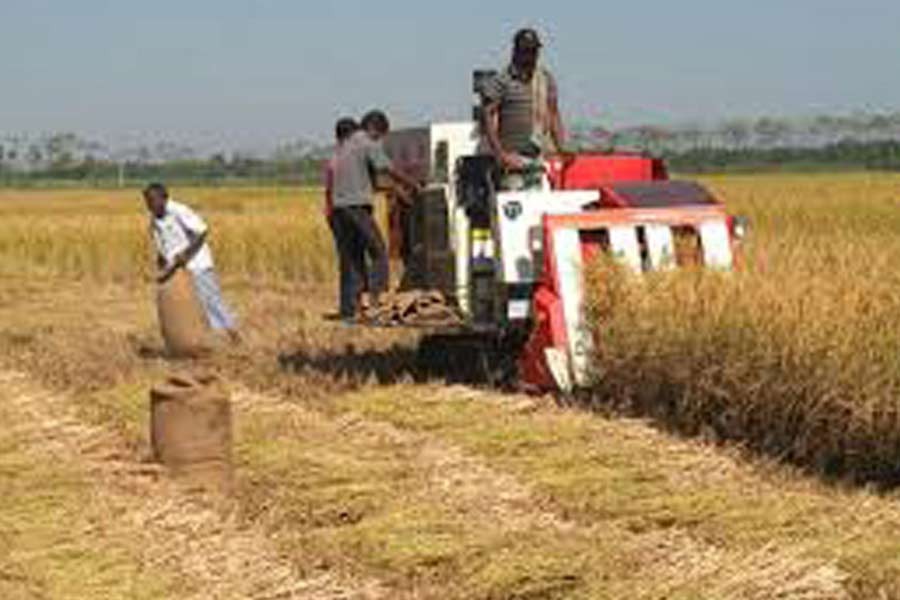Farming is the lifeblood; how can you live without it? Farming again is time-bound. You cannot grow the crops of summer in the winter, and in the monsoon, we have fresh crops unlike in the summer. There are times for preparing and ploughing lands, then planting, weeding, spraying fertilisers, pesticides- so many work to do. Then comes harvesting, reaping and takingthe crops home.
When we consider our principal crops- paddy and wheat, their harvesting is an enormous issue now. These crops take the golden colour in all the fields around the country almost ar the same time and ultimately ripen for reaping nearly the same time; the concern of the farmers intensify where to get the needed labours to reap the harvest. It's now difficult for the big farmers also to get the labourers, not because of the escalating daily wages but due to supply shortage. Most of our young rural people are gravitating to the big job hubs like Dhaka, Chottogram, Joydebpur etc. for being employed in industrial units which need skilled and unskilled manpower.
We cannot also ignore the process of industrialisation. The young people whose ancestors lived on farming alone do not get attraction in farming now. They prefer to stay in cities and office-based jobs and love to spend their idle time in recreation and roaming around. The young generation's parting ways with farming makes the average age of our farmers around 48 now, though it should have been between 30 and 40. .
During the Covid-19 pandemic our farmers did not stop working. They went to their fields regularly despite the risk of infection. During the Boro harvesting season, they kept themselves busy and vigilant without sleep. This time Boro has seen a good yield, almost on 4.12 million hectares of land comprising the haor and the plain areas. The country would have suffered an enormous setback if the farmers were not able to harvest the paddy in time.
The government has, however, played a major role by promoting the use of combine harvester and reaper machines as well as providing a substantial subsidy against the prices of the harvesting equipment. During this Boro season, the government allotted Taka 2.0 billion as subsidy for the combine harvester and the reaper. Combine harvester is a somewhat expensive machine that can simultaneously separate the grain of the crop in its tank and put the long grass outside in the field, thrash, dry, and pack the grains automatically. The combine harvester can do this job at one acre of land per hour with only 11 litre of diesel and one labour cum driver. Ratio of wastage is less than 2.0 per cent whereas in the manual harvesting it is almost 15.0 to 20.0 per cent. The total loss is equal to the requisite amount of rice for a big district of the country. Currently, only 2.0 per cent of our total harvesting is done through machines like these harvesters and reapers. The government is liberally allowing 70.0 per cent subsidy for tese machines in the haor areas and 50.0 per cent for the other areas.
Cultivation of land in Bangladesh has seen a resounding success in using tractors and power tillers. It is now a rare scene to find farmers using bullocks for tilling the land. Almost 95.0 per cent of cultivation has come under mechanisation by using the tractors or the power tillers.
The effort for mechanisation should now go on principally for harvesting and rice transplantation. The manual labourers engaged in these two activities need replacement as quickly as possible. In rice transplantation, the ratio of mechanisation is below 1.0 per cent and in harvesting, it is around 2.0 per cent. The subsidy should be increased in the budget. Though farmers are getting interested in using harvesters and reapers, they are yet to use the rice transplanter in a big way. Rice transplanting involves a stage of transferring the seedlings to a tray and afterward farmers have to place the trays on the machine and then drive it in the field to transplant the seeds in systematic rows. It requires robust training for the farmers to learn the skill.
Banks do not finance the farmers directly for purchasing agri-machinery. Usually, the importers or distributors of these types of machines directly sell these to the farmers on lease against every month instalments (EMIs) for thirty-six months or more. Banks need to move ahead with easy-to-use financing packages for the farmers. As the government pays 50.0 to 70.0 per cent subsidy and the farmers can pay a down payment of 15.0 to 25.0 per cent and the exposure of a single farmer will be not high. The Banks may also finance local service provider groups and create rural entrepreneurs with tiny funds while the government is paying big subsidy. At present, there is a requirement that 5.0 per cent of the loanable fund has to go in agriculture. But there is no segregation for mechanisation, especially financing to purchase combine harvester, reaper or rice transplanter.
Mechanisation of agriculture will help to reduce the cost of production, wastage of food grain as well as dependence on farm labourers extensively. It will also help minimising the duration of the production cycle of any crop and the fields will become ready for the next crop quickly. It will also create opportunities for young people to work in industries.
The writer is an ex-senior banker and presently working as CEO of an agribusiness group, amm.


